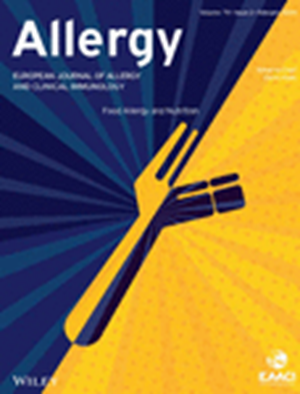Myeloid cAMP Reduction Shifts Rhinovirus‐Induced Airway Inflammation From Neutrophilic to Eosinophilic by Suppressing M1‐Interstitial Macrophages
IF 12
1区 医学
Q1 ALLERGY
引用次数: 0
Abstract
BackgroundAsthma exacerbations caused by human rhinovirus (hRV) infection are characterized by airway neutrophilia and reduced corticosteroid response, leading to significant healthcare costs and lung function impairment. The Gαs subunit of the trimeric G protein regulates immunopathological conditions by modulating cAMP levels. We aimed to investigate the impact of myeloid cAMP levels on neutrophil‐dominated asthma exacerbation caused by hRV infection.MethodsWe generated mice with myeloid cell‐specific deletion of the Gαs subunit by targeting the LysM gene, leading to a specific reduction of cAMP in myeloid cells. Neutrophilic asthma exacerbation was induced by hRV infection during allergen challenge, and cytokine production in BALF and lung tissue was assessed, along with histological examinations.ResultsMyeloid Gαs ablation was found to shift airway inflammation from a neutrophilic to an eosinophilic phenotype during hRV‐induced asthma exacerbation. This change led to mucus hypersecretion and Th2‐type inflammation, and enhanced CD4髓系cAMP减少通过抑制M1 -间质巨噬细胞使鼻病毒诱导的气道炎症从嗜中性粒细胞变为嗜酸性粒细胞
背景:人鼻病毒(hRV)感染引起的哮喘加重以气道中性粒细胞增多和皮质类固醇反应降低为特征,导致显著的医疗费用和肺功能损害。三聚体G蛋白的Gαs亚基通过调节cAMP水平调节免疫病理状态。我们的目的是研究髓系cAMP水平对hRV感染引起的中性粒细胞主导的哮喘加重的影响。方法:我们通过靶向LysM基因产生髓细胞特异性Gαs亚基缺失小鼠,导致髓细胞cAMP特异性降低。在过敏原攻击期间hRV感染诱导中性粒细胞哮喘加重,并评估BALF和肺组织中细胞因子的产生,以及组织学检查。结果发现,在hRV诱导的哮喘加重期间,髓样Gαs消融术可将气道炎症从嗜中性粒细胞表型转变为嗜酸性表型。这种变化导致粘液分泌增多和Th2型炎症,并增强CD4+ Th2效应细胞的扩增。在反复暴露于过敏原和hRV的慢性哮喘患者中,髓系Gαs消融术引起Th2 -和Th17 -混合性偏倚炎症,伴中性粒细胞和嗜酸性粒细胞浸润和胶原沉积增加。髓系Gαs缺乏阻碍NLRP3炎性体的激活,从而抑制嗜酸性炎症中间质巨噬细胞的M1极化。巨噬细胞中的cAMP水平可能与M1极化有关,因为cAMP类似物通过PKA和EPAC途径调节NLRP3炎性体的激活。最后,经cAMP类似物处理的巨噬细胞过继转移可逆转hRV感染后髓系Gαs消融小鼠嗜酸性粒细胞到嗜中性粒细胞的炎症。这些结果强调了巨噬细胞cAMP在hRV诱导的哮喘加重期间类固醇抵抗性、中性粒细胞主导的气道炎症中的重要作用。
本文章由计算机程序翻译,如有差异,请以英文原文为准。
求助全文
约1分钟内获得全文
求助全文
来源期刊

Allergy
医学-过敏
CiteScore
26.10
自引率
9.70%
发文量
393
审稿时长
2 months
期刊介绍:
Allergy is an international and multidisciplinary journal that aims to advance, impact, and communicate all aspects of the discipline of Allergy/Immunology. It publishes original articles, reviews, position papers, guidelines, editorials, news and commentaries, letters to the editors, and correspondences. The journal accepts articles based on their scientific merit and quality.
Allergy seeks to maintain contact between basic and clinical Allergy/Immunology and encourages contributions from contributors and readers from all countries. In addition to its publication, Allergy also provides abstracting and indexing information. Some of the databases that include Allergy abstracts are Abstracts on Hygiene & Communicable Disease, Academic Search Alumni Edition, AgBiotech News & Information, AGRICOLA Database, Biological Abstracts, PubMed Dietary Supplement Subset, and Global Health, among others.
 求助内容:
求助内容: 应助结果提醒方式:
应助结果提醒方式:


